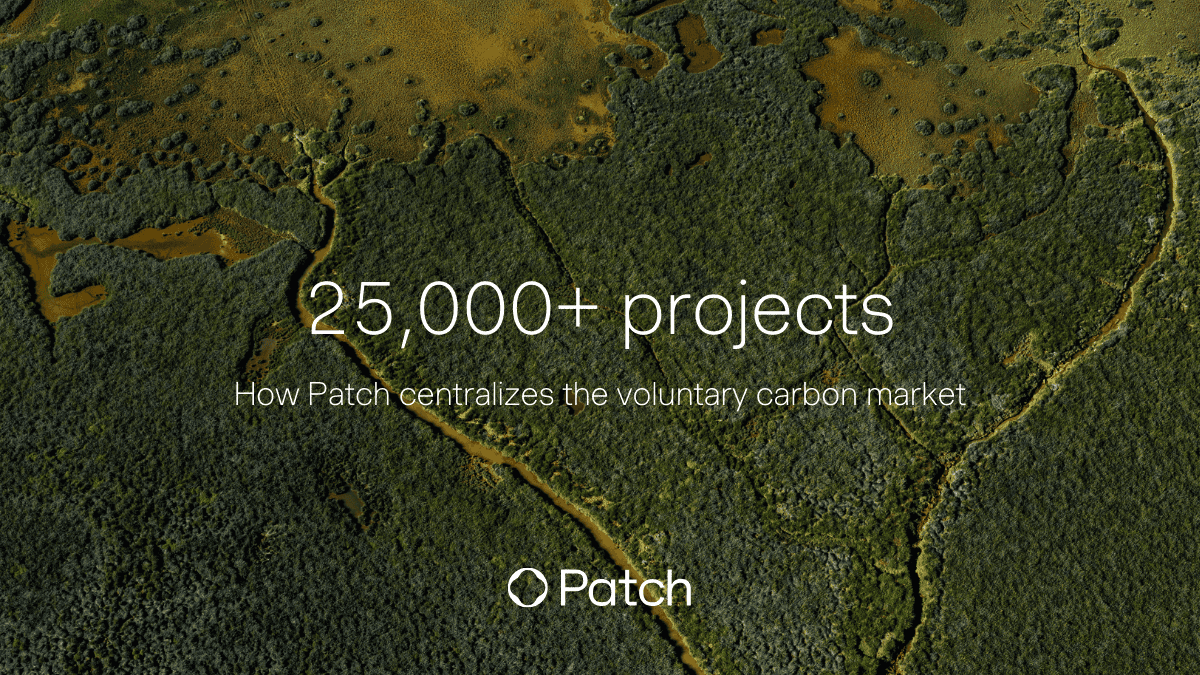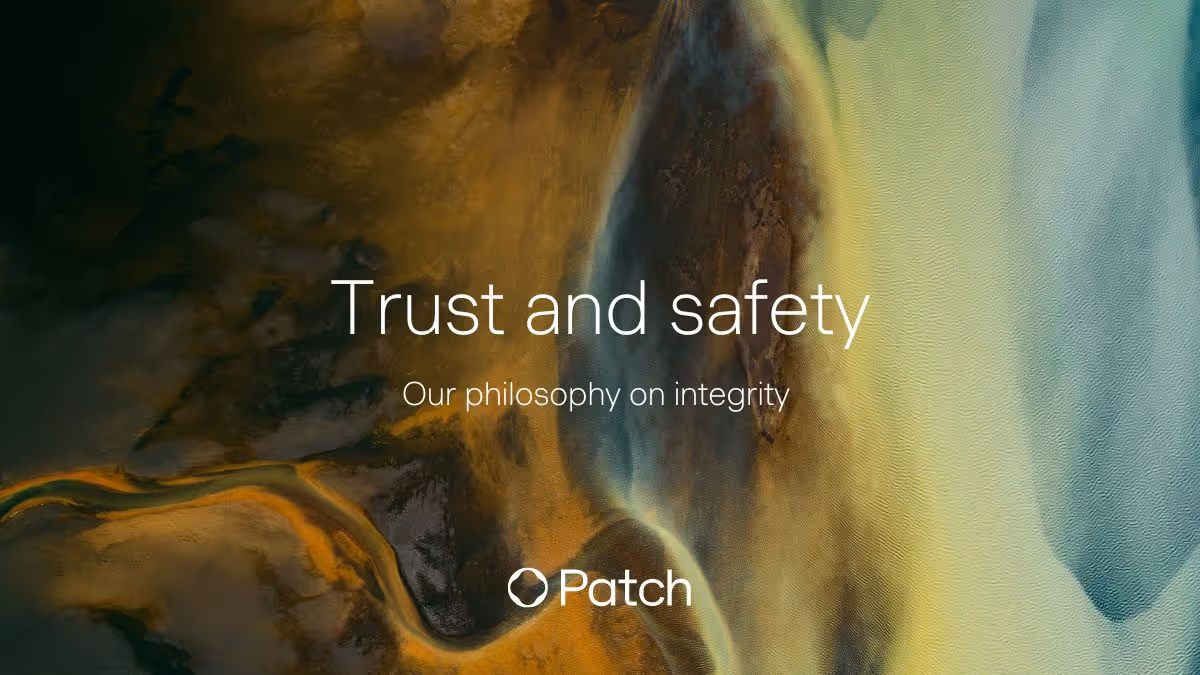Patch is on a mission to rebalance the planet, but how can we expect to do that if we can’t rebalance ourselves?
That’s why, starting last year, we embarked on a mission to practice what we preach and neutralize the lifetime emissions of our company going back to our founding in 2020. This Earth Week, we’re proud to share the first part of our Patch Rebalanced journey.
Why now — three years later?
The truth is we’re at a pretty early stage to be taking this journey. On one hand, that makes it much more feasible to go back and estimate our historical emissions and much less expensive to do it now versus waiting until we’re more mature. On the other, we don’t have the same resources as much larger companies, which meant this was going to be a learning experience.
And that’s another reason for why now.
At Patch, we work with companies every single day making similar decisions for the sustainability of their business. We’ve got deep experience with carbon markets, but it’s one thing to advise customers on their climate strategy — it’s another to build one for your own business.
This was a chance for us to walk in their shoes, as well as experiment with new approaches and learn new ways of understanding the whole process, from measuring to budgeting to selecting a carbon credit portfolio.
And above all, it was a chance to engage our customers, our partners, and most of all, our employees. This initiative was ultimately driven and led by our internal team, and we wanted our approach to rebalancing the company to involve every one of us.
Our goals for Patch Rebalanced
First and foremost, as with the planet, rebalancing a company will be an ongoing process. All that we’ve achieved at this point is a first step. As such, simply learning more about ourselves and our path was the goal overarching everything else.
But underneath that, we had four goals laddering up to that:
- Set a foundation: This is the beginning of a Patch Rebalanced, not the end. But it will form the basis for all our subsequent compensation and reduction efforts going forward.
- Define the scope: Corporate sustainability contains a multitude of vectors for action. With learning as the key goal, we wanted to clearly define what we’d focus on and what we’d save for the next iterations.
- Demystify the process: We know climate strategy can be equal parts confusing and daunting. It’s hard to know if you’re doing the right thing when peers can be reluctant to share their processes. We had a goal to document and share our learnings to help demystify corporate climate action, as well as test out new ideas so we could be even more prescriptive with our customers.
- Lead from the front on compensation: Carbon credits cost anywhere from a few bucks to a few thousand, and we see companies' budgets for credits on a price-per-tonne basis vary almost as much. Even though price isn’t everything when it comes to evaluating the impact of a climate budget, we wanted to be ahead of the curve, not behind. Pushing ourselves on per-tonne spending was critical to setting an example for other companies our size.
Our approach to rebalancing Patch
At Patch, we have a wealth of internal knowledge throughout our employee base, but especially in our Climate Solutions & Strategy team. We’ve consulted on countless compensation and contribution strategies. At the same time, we’re at the nexus of more than 40 partners with robust accounting tools and experts.
We had to decide how we’d approach our goals through a human lens while engaging both employees and partners.
Engage our employees: Like many climate tech companies, our employee-base ranks pretty highly in terms of personal sustainability. Since our inception, we’ve had internal initiatives for everything from eating less meat and animal products to installing home heat pumps. One of our most popular Slack channels is called #personal-sustainability, where we share tips and tricks on minimizing environmental harm. Our Patch Rebalanced program was a chance to celebrate those successes and give our team a chance to go even further — which we’ll get to later.
As far as the tiger team running point on the project, we had our driving force, Keeton Ross, our data expert, Brendan O’Connell, our head of finance, Andrew Fu, buy-in from our co-founders, and marketing and administrative support as well.
Engage our partners: With dozens of partners, a limited budget, and a self-imposed timeline for phase one of our rebalancing effort, we reached out to several of our partners and narrowed down a list of collaborators for this first step. We were looking for carbon accounting partners (CAPs) that matched our company size and budget, and fit our general business model. Some of our CAPs offer highly bespoke approaches driven by human capital, some are more self-serve. Others focus on specific supply chains, like food.
We used our own Partner Directory tool to help narrow down our list, and in the end, we worked with Persefoni, Greenly, Normative, and Carbon Neutral Club. They offered a good mix of self-serve tools that fit our strategy, and in the case of Carbon Neutral Club, the employee engagement element.
So, how exactly did we do it?
Step 1: Data
Even before we looked at CAPs, we started collecting and cleaning up our data — almost 4,000 lines of QuickBooks data. And we categorized it — spend-based (mostly scope 3 spending — technology and contractors), activity-based (flights, meals, hotels, etc.), miscellanea non-relevant to our footprint. We mobilized our whole employee base to go back into all past spending and categorize flights, taxis, trains, rental cars, hotels — all of it.
This part had two outputs: first, it would help us use our own internal footprint estimation technology to get an estimate of roughly what our emissions might be, and secondly, it was a necessary task ahead of using the self-service footprinting offerings from our CAPs.
That’s a key takeaway: your footprinting process will likely involve cleaning up data, and the more history you have, the more data cleaning you may have in front of you. Here’s a small but annoying example: we had some travel labeled as “NYC” and some labeled as “JFK” which had to be reconciled manually.
Footprinting software can actually streamline the categorization process, which brings us to step 2.
Step 2: Footprinting
Most companies choose a single CAP for their footprint estimate, but with our goal of demystification in mind, we thought we’d compare the experience and results of a few. We’ll be publishing a much more detailed breakdown of our footprinting learnings in the near future, but for now let’s just look at some topline takeaways.
First of all, some of the self-serve tools required more manual work than others. Each will give you a starting point for your categorization, but with some are much more turnkey while others are more manual. Categorization is definitely not standardized across them, either, which is part of the reason why our footprints were different in each calculator as well.
Another part of the reason? Each CAP is actually calculating the same activity or spend differently based on varying life cycle assessments, non-CO2 GHG emissions factors, and regional standards. If you only look at one footprint assessment, you don’t necessarily have a problem. But what footprint do you go with when you have three?
Looking purely at dollars and cents, we’d be incentivized to pick the lowest one. But you can probably imagine what the response to that choice would be when we published it. Another option would be to dig through the criteria and pick and choose the granular factors we felt were more accurate, essentially building our own hybrid score. Apart from being time-consuming, that would defeat the purpose of having footprinting done by a disinterested third party.
In the end, we decided to go with the average versus picking any single one.
Lastly, as a remote-first company, an unignorable part of our carbon footprint was intrinsically tied to individual employee behaviors and living/working environments. In Persefoni and Greenly, for example, estimating these was based around a survey. But Carbon Neutral Club helped us go one step further, which takes us to employee engagement.
Step 3: Employee engagement
Through Carbon Neutral Club (CNC), we sent out an assessment to all our employees, who submitted their work-related emissions data through an interactive web experience. We liked CNC because it’s more than a survey — there’s also the educational aspect plus the access to rewards and discounts on sustainable goods. We factored the total employee footprint into our other footprint estimates as well.
But the most exciting part of the process was engaging our whole team in actually selecting the projects we’d be using to compensate for our footprint.
We’ll also have a much more in-depth look at this process soon, but we used Patch in a bit of a dog-fooding exercise to explore a few different compensation and contribution approaches. Long story short, each individual teammate was able to select their own portfolio of carbon credits given a budget and a spending criteria (like $1000 to spend however you like, or pick 10 credits at an average price-per-tonne of $130, etc.).
Step 4: Reduction & compensation
You might have caught that “$130 average price-per-tonne” in the last paragraph, which is what we decided on for our compensation budget. We know that’s a bit higher on the bell curve of corporate spending, but one of our goals was to “lead from the front.” By no means is it the highest we’ve seen. We’re a climate company, but also a privately-funded startup — financial responsibility is a huge priority for every single one of our customers, and it was for us as well.
We’ll soon be releasing an in-depth guide to budgeting for a climate strategy that will include learnings from our own exercise, as well as benchmarks from our own customer data. “Coming soon” is a bit of a theme in this article, but feel free to subscribe at the bottom of the page to get notified when this content is released.
Most importantly, no Patch Rebalanced effort would be complete without addressing reduction. And that’s why we can’t yet call ourselves a rebalanced company. We have some work to do on reducing our emissions, but it’s going to be tough. Like a lot of early stage, fully-remote companies, our total footprint ended up being relatively small, only about 600 tonnes over three years, comprising mostly scope 3 emissions.
But for a company like ours, footprinting was a necessary first step of the reduction process, and compensating it was likewise intuitive once we had the estimates.
The next steps will include surveying vendors to get a more accurate picture of our scope 3 emissions, getting a travel management system to help us track and reduce transit emissions, and looking into a co-working space running on renewable energy.
The future of Patch Rebalanced
Designing and implementing our own climate strategy has given all of us at Patch a much deeper sense of empathy for our customers. Even though we help companies do this on a daily basis, there’s a huge sense of responsibility to “get it right” — especially since this is our wheelhouse.
We fought with an urge to undersell or at least not overshare the specifics. We fought our own “greenhushing” battle. In the end, we tell all our customers that every climate strategy is iterative — and ours is no different. Going forward, this exercise will help us set benchmarks for the future, define repeatable processes, and prescribe our reduction actions.
The more transparent we can be, the more we’ll learn — and the more we’ll be able to teach.
Even though we’re talking about this in the week leading up to Earth Day, all of our work has been happening and will continue to happen throughout the year. In the next weeks, we’ll be releasing much more in-depth content about our process. Subscribe below to get all the updates.






